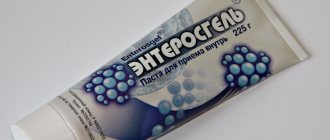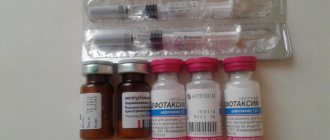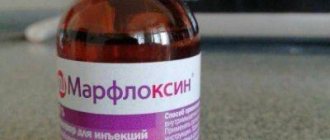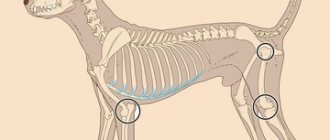No-spa for dogs is used for spasm and pain due to inflammation, stones in the urinary and bile ducts, and damage to the gastrointestinal tract. It is used in combination with painkillers after surgery, anticonvulsants for seizures, Cerucal for vomiting and diarrhea. At high temperatures, use with Diphenhydramine and Analgin injections.
Despite its reasonable safety, it is prescribed only after a veterinary examination; in case of an overdose, a slowdown in heart rate occurs. When given as injections, it relieves pain in 5-15 minutes; when taken in tablets, it relieves the animal’s condition in 30-45 minutes. No-spa is contraindicated in cases of severe renal and liver failure; it should be administered with caution to puppies, pregnant and lactating females.
When do you need No-spa for dogs?
No-spa for dogs is prescribed if necessary to relieve pain due to spasms of smooth muscles of the stomach, intestines, urinary and biliary tract, and vascular walls. It is needed when:
- stones in the gall bladder, kidneys (attacks of biliary and renal colic) to restore the outflow of bile or urine;
- inflammation of the intestines (colitis, enteritis), biliary tract (cholangitis) and bladder (cholecystitis), bladder (cystitis), kidneys (pyelitis) to reduce pain;
- ulcers of the stomach, duodenum or intestines (relieves pain and spasms);
- spastic constipation to facilitate bowel movements;
- increased tone of the uterus in pregnant females (prevents interruption of pregnancy);
- complications after surgery in combination with other painkillers;
- carrying out diagnostic procedures to prevent spasm of smooth muscles (for example, when examining the stomach with an endoscope).
How to help with epilepsy
No-spa for epilepsy helps relieve spasm of the arteries and improve blood flow to the affected part of the brain tissue. Sometimes a veterinarian may recommend it if a seizure occurs due to high blood pressure. The drug does not have a direct anticonvulsant effect, so for epileptic seizures it is always prescribed with other medications.
Why is it given when vomiting?
No-shpa for vomiting is administered in injections along with Cerucal (antiemetic), vitamins and glucose in order to relieve spasms of the stomach and intestines and stop increased peristalsis (contraction of the walls). It is important that the animal is examined by a veterinarian before injections, since suppressing vomiting is dangerous if the dog has swallowed a foreign object.
We recommend reading about the dosage in which Analgin can be used for dogs. From the article you will learn about the characteristics of the drug, indications for use in a pet, side effects, use in injections and tablets.
And here is more information about what painkillers can be used in dogs.
How to quickly help with pain
No-spa begins to act within 15 minutes after an injection into the withers and 5-7 minutes when administered intravenously, and when taking pain relief pills you need to wait about 30-45 minutes. Therefore, during an acute painful attack, the drug is most often prescribed by injection, and the veterinarian recommends internal use for chronic, moderate-intensity sensations.
Indications for treatment
No-Shpa is an effective antispasmodic, used both independently and as part of a variety of therapeutic regimens. The drug is widely used in veterinary medicine, and it shows especially good results in the treatment of domestic animals.
No-Spa effectively relieves spasms in dogs.
The drug reduces the tone of the muscles of the gastrointestinal tract, genitourinary system, biliary tract, dilates blood vessels, and normalizes blood flow. The effect on smooth muscles relieves painful spasms and improves the dog’s condition.
The drug is actively used for:
- colitis;
- urolithiasis;
- renal colic;
- cholecystitis;
- cystitis;
- stomach ulcer;
- constipation;
- postoperative complications;
- increased uterine tone in pregnant females.
Important. The drug does not affect the functioning of vital organs, does not accumulate in the liver or kidneys, and does not affect the central nervous system.
The medicine is available in the form of film-coated tablets or injection solutions. When administered intravenously, the drug begins to act within a few minutes, after half an hour the medicine reaches its maximum effect.
No-Shpa is available in yellow, film-coated tablets or solution for injection.
The drug is prescribed for preventive purposes before various studies. The medicine relieves muscle spasms and allows for more accurate instrumental diagnostics. The remaining active substances are completely eliminated from the body after 72 hours along with urine and bile.
No-spa for a dog: dosage
The dosage of No-shpa for a dog is calculated per 1 kg of animal weight - 4 mg/kg, so for small breeds one tablet (40 mg) is divided several times, and part of the solution is taken from an ampoule (20 mg in 1 ml). The veterinarian can reduce the dose when combining No-shpa with other drugs; in case of severe pain, an increased dosage is administered once, but under the supervision of a specialist.
Is there an overdose of injections, tablets?
If the dose is calculated incorrectly (in the case of self-administration), or if the dog accidentally takes the tablets (rarely due to the bitter taste), an overdose occurs in the form of slow heartbeat. In case of severe poisoning, conduction blockade in the heart muscle is possible, resulting in cardiac arrest and death of the animal. A slight excess of the double dose leads to nausea, vomiting, and vascular collapse (pressure drops sharply).
If large quantities of the solution are injected, then you need to immediately take the dog to the clinic. There she is given IV drips with drugs that improve heart function. In case of an overdose of tablets, you should try to induce vomiting. To do this, water is injected into the mouth through a syringe or hydrogen peroxide half diluted with water is dripped onto the root of the tongue at the rate of a teaspoon per 5 kg of weight.
No-Spa: antispasmodic for people and dogs
Drugs intended for humans are often used to treat dogs. One of these remedies is No-Shpa. The medicine effectively relieves spasms and colic and is used to treat animals of all breeds. It is possible to use tablets or injections, side effects are rare.
Indications for treatment
No-Shpa is an effective antispasmodic, used both independently and as part of a variety of therapeutic regimens. The drug is widely used in veterinary medicine, and it shows especially good results in the treatment of domestic animals.
No-Spa effectively relieves spasms in dogs.
The drug reduces the tone of the muscles of the gastrointestinal tract, genitourinary system, biliary tract, dilates blood vessels, and normalizes blood flow. The effect on smooth muscles relieves painful spasms and improves the dog’s condition.
The drug is actively used for:
Important. The drug does not affect the functioning of vital organs, does not accumulate in the liver or kidneys, and does not affect the central nervous system.
The medicine is available in the form of film-coated tablets or injection solutions. When administered intravenously, the drug begins to act within a few minutes, after half an hour the medicine reaches its maximum effect.
No-Shpa is available in yellow, film-coated tablets or solution for injection.
The drug is prescribed for preventive purposes before various studies. The medicine relieves muscle spasms and allows for more accurate instrumental diagnostics. The remaining active substances are completely eliminated from the body after 72 hours along with urine and bile.
Release form and packaging
The medicine is available in the form of tablets and solution for injection. Round biconvex tablets are coated, the main active substance is drotaverine hydrochloride. Pills weighing 40 or 80 mg are packaged in plastic blisters of 20 pieces, each packed in a cardboard box and supplied with instructions.
The solution for injection is a clear, colorless liquid. Packaged in dark glass ampoules of 2 ml, placed in plastic contour packaging of 5 pieces each. 2 blisters are placed in a cardboard box.
Instructions for use
No-Shpa tablets and solutions according to the instructions can be used not only for people, but also for dogs. Animals are prescribed medicine in tablets or injections. The choice of form depends on the condition and individual reaction of the animal.
No-spa is prescribed to dogs in a dosage depending on body weight. Tablets are given to dogs whose weight exceeds 10 kg. Smaller animals are offered intramuscular injections; in some cases, No-Shpa is administered subcutaneously to the dog.
For every 10 kg of dog weight, give 1 tablet of No-Shpa or 1 ml of solution.
Typically, the dosage is calculated depending on the dog's weight:
- For 10 kg of weight, 1 tablet of 40 mg or 1 ml of solution for injection is prescribed.
- Larger dogs are given 80 mg tablets, this pill is designed for 20 kg of weight.
The exact course is prescribed by the doctor, it all depends on the disease, the symptoms that need to be relieved, and the medications included in the general therapeutic regimen.
The tablets can be placed on the root of the tongue or given along with a small portion of food. Injections are made without prior dilution of the solution; it is preferable to use insulin syringes with particularly thin needles. For emergency treatment of especially small dogs, intramuscular injections are suitable; they are given in the upper third of the thigh.
Important. Intravenous injections are used much less frequently; the risk of complications and side effects is too great.
Contraindications and side effects
The drug has a low hazard class and can be prescribed to dogs of different breeds. Suitable for weakened and elderly animals; when treating pregnant and lactating bitches, veterinary supervision is required. Tablets and injections are administered to puppies with caution.
Dogs tolerate tablets and intramuscular injections better. Opinions regarding intravenous injections are divided. Some veterinarians believe that the risk is too great in this case, and unpleasant side effects may occur if the dosage is incorrect.
Dogs tolerate intramuscular injections of No-Shpa well, but it is better to avoid intravenous administration.
Among them:
- a sharp drop in pressure;
- cardiac arrhythmia;
- depression of the respiratory center.
In especially severe cases, collapses were recorded. In modern veterinary medicine, intravenous injections of No-shpa are used only in extreme cases.
Despite its low toxicity, No-shpa can be dangerous for dogs. In case of an overdose of tablets, nausea, vomiting, depression, loss of appetite or short-term convulsions are possible. No special treatment is required, unpleasant symptoms completely disappear after 1-2 days.
In some cases, an individual allergic reaction is observed; if corresponding symptoms are detected, taking the pills must be stopped. Anticholinergics will help soften the effect of the drug. They are necessary in the treatment of stomach or duodenal ulcers.
Reviews from dog breeders
Galina, Tyumen. My Australian Shepherd suddenly started vomiting. At first I chalked it all up to ordinary food poisoning; the dog was quite cheerful. But during the day the vomiting repeated, the dog became bored, began to refuse food and hide. We took him to the vet.
The preliminary diagnosis is colitis. It wasn't that bad, but the dog was clearly in pain. They prescribed No-shpa in tablets. She gave it along with wet food, but then she just started throwing it at the root of the tongue. A day later the dog felt better, now we are going through a series of tests, we are afraid of a recurrence.
Many dog owners have No-Shpu in their first aid kit.
Nadezhda, Nizhny Novgorod. I always have No-spa in my medicine cabinet, I use it to relieve stomach cramps. Therefore, when the operated dog was prescribed these tablets, he didn’t even have to go to the pharmacy.
The doctor said that the medicine would relieve colic from gases, and it was harmless for animals. He offered an injection, but I refused - it was scary. It’s better to take pills, it’s more familiar. The dog is recovering normally, I give him 2 tablets a day.
We don’t take painkillers, and everything is fine.
Stanislav, Kazan. I ran into a problem - after giving birth, my Dalmatian started having cystitis. The veterinarian prescribed antispasmodics in tablets, but the dog refused to take them.
In the end we settled on injections. It turned out that No-shpa subcutaneously is what a dog needs. There were no side effects, the symptoms of cystitis went away after 3 days, but we honestly completed the entire course.
I recommend it, it’s not as scary as some people think.
Source: https://sobaki-pesiki.ru/no-shpa-dlya-sobak-dozirovka-pokazaniya.html
How to give a No-shpa tablet to a dog
To prevent the dog from spitting out the No-shpa tablet, it must be placed on the root of the tongue and the mouth closed, stroke the animal, and calm it down. You can also mix the drug with food if you have a good appetite and no vomiting. If you weigh up to 5 kg, give a quarter of a tablet, 5-10 kg - half, from 10 kg you can give a whole tablet. Large breed dogs may need 2-3 pieces at once during a painful attack.
Instructions for use
No-Shpa tablets and solutions according to the instructions can be used not only for people, but also for dogs. Animals are prescribed medicine in tablets or injections. The choice of form depends on the condition and individual reaction of the animal.
No-spa is prescribed to dogs in a dosage depending on body weight. Tablets are given to dogs whose weight exceeds 10 kg. Smaller animals are offered intramuscular injections; in some cases, No-Shpa is administered subcutaneously to the dog.
For every 10 kg of dog weight, give 1 tablet of No-Shpa or 1 ml of solution.
Typically, the dosage is calculated depending on the dog's weight:
- For 10 kg of weight, 1 tablet of 40 mg or 1 ml of solution for injection is prescribed.
- Larger dogs are given 80 mg tablets, this pill is designed for 20 kg of weight.
The exact course is prescribed by the doctor, it all depends on the disease, the symptoms that need to be relieved, and the medications included in the general therapeutic regimen.
The tablets can be placed on the root of the tongue or given along with a small portion of food. Injections are made without prior dilution of the solution; it is preferable to use insulin syringes with particularly thin needles. For emergency treatment of especially small dogs, intramuscular injections are suitable; they are given in the upper third of the thigh.
Important. Intravenous injections are used much less frequently; the risk of complications and side effects is too great.
No-spa: instructions for dogs, how many injections to give
According to the instructions, No-Spa is injected into dogs at the withers or intramuscularly into the thigh; in severe cases, intravenous injections are required. They are done for pain, so there is no precisely established course; the drug can be used once or, if necessary, it is administered for 5-10 days.
Intramuscularly into the thigh
No-spa can be injected intramuscularly into the thigh, but this method is used less frequently, usually when injections into the dog’s withers are not possible. The animal is placed on its side and a muzzle is put on, an assistant holds the hind paw. Before injection, you need to feel the soft muscle tissue, then an injection is given in this place using the same method as at the withers, only you do not need to gather the skin into a fold.
Intramuscular injection
Introduction from ampoules to the withers
To introduce No-shpa from an ampoule into the withers, the dog needs:
- Warm the ampoule in your hands and break off the tip, draw the required amount (1 ml per 5 kg of weight) into a syringe with a thin needle, remove excess air, put the protective cap on the needle.
- Gather the skin at the withers into a fold and hold it until the injection is completed.
- Remove the cap from the needle and point the syringe strictly perpendicular to the fold.
- Insert the needle and release the solution.
- Remove the needle.
Watch this video on how to give a dog an injection at the withers:
Intravenously
Intravenous administration of No-shpa is carried out by a veterinarian in a clinic setting. For this:
- The hair on the front or back paw is trimmed.
- The dog is fixed, the limb is clamped above the injection site so that the vein appears.
- After piercing the skin, the needle is held parallel to the surface, the piston is slightly pulled towards itself so that blood appears in it to check whether it has entered the vessel.
- Remove the tourniquet and release the solution.
Intravenous injection
Is it always possible to No-shpu a dog?
No-spa is considered a fairly safe drug for dogs if the prescribed dose is followed exactly. The medication does not accumulate in the animal’s body and is excreted by the kidneys, urine and bile through the intestines, however, contraindications to this medicine have been established:
- intolerance to the active substance (drotaverine) or auxiliary components (allergy in the past);
- severe kidney and liver diseases with deterioration of their function (renal, liver failure);
- weakness of the heart muscle.
The drug is allowed for pregnant women, but is administered with caution, as well as for puppies, during lactation, and in exhausted and weakened animals.
When is it preferable to administer a mixture of No-spa + Analgin + Diphenhydramine to a dog?
The combination of No-Spa + Analgin + Diphenhydramine ampoules is most often used for high fever in dogs. In this case, No-Spa relieves vascular spasm, Analgin has an antipyretic effect and relieves pain, and Diphenhydramine soothes and eliminates allergic reactions. The dosage of this mixture is 0.1 ml per 1 kg of weight.
For example, an animal weighs 6 kg, then you need to inject 0.6 ml, so for one injection you take 0.2 ml of each component. You can perform 2 injections per day.
Indications for use
The use of the drug is justified in the following clinical cases:
- hypertonicity of the uterus in pregnant bitches;
- colic of various etiologies;
- cholecystitis and cystitis;
- stomach ulcer;
- allergic reactions and skin itching caused by them;
- a sharp decrease in blood pressure of unknown etiology;
- constipation;
- complications after various surgical interventions;
- urolithiasis, etc.
No-spa relieves colic of various etiologies
In these, and many other cases, No-Spa can quickly and effectively solve the existing problem, both as the main therapy and as part of complex therapy, which is carried out according to certain schemes and in accordance with current protocols for the treatment of certain diseases in dogs.
Analogues of the drug
An exact analogue of No-shpa is Drotaverine; Papaverine has a similar effect. If necessary, the veterinarian may prescribe other drugs with an antispasmodic effect:
- Spasmalin,
- Spasmopharm,
- Spazgan,
- Trinalgin,
- Spasmalgon,
- Maxigan,
- I took it.
We recommend reading about when to give Baralgin to your dog. From the article you will learn about the characteristics of the drug, indications for use, dosage in injections and tablets, analogues.
And here is more information about whether and when you can give your dog Paracetamol.
No-spa is prescribed to dogs for pain and spasm of smooth muscles of blood vessels, urinary, biliary tract, and gastrointestinal tract. It is used in tablets for chronic diseases, but during an attack, an injection into the withers, thigh or intravenous administration of the drug is recommended.
Useful video
Watch this video for instructions on how to use No-shpa:
Similar articles
- Painkillers for dogs: which ones can be given...
No-Spa. An antispasmodic agent is used to relax the smooth muscles of internal organs during spasm... In tablet form, the dose of No-Shpa for a dog is 40 mg per 10 kg, in injection form - 1 ml of solution for every 10... Read more - Analgin for dogs: when used in veterinary medicine...
Analgin for dogs is used as a temporary pain reliever. Can be administered in injections - 0.5-2 ml for small breeds and up to 5 ml for large animals. For moderate pain, it is allowed to give tablets - 1/2 or... Read more
- Paracetamol for a dog: how much to give at a temperature...
Is it possible to give Paracetamol to a dog? How much antipyretic is permissible to give at a fever, permissible dosage. Can there be a lethal dose of Paracetamol in veterinary medicine? Read more
- Baralgin to a dog: how to give, dosage in injections...
Baralgin for dogs: dosage in injections. To calculate the required dosage of Baralgin in injections, you need to know the animal’s body weight. The required quantities are indicated in the table, but the veterinarian can give an individual recommendation. Animal weight in kg. Dose in ml for 1 injection. Read more
- Anti-inflammatory for dogs: basic…
For various painful conditions, after operations, injuries, anti-inflammatory drugs are used for dogs. The main non-steroidal drugs are produced in drops, ointments, injections, tablets, suppositories and suppositories. Read more
Daily portion by weight
For small breeds
As a rule, tablets are prescribed for individuals weighing over 10 kg; injections are indicated for smaller dogs.
The dosage is 1 ml of solution per 10 kg of weight, no more than two injections are performed in total, respectively, the daily dosage is 1 or 2 ml. But in each individual case it is determined by the doctor individually.
For large
Tablets are recommended for large dogs. A maximum of two are prescribed at the rate of one tablet (40 mg of active substance) per 10 kg of weight. If necessary, the maximum dosage is 80 mg of the main substance or 2 ml if we are talking about injections.
How many times?
No-shpu, both in the form of tablets and in the form of injections, cannot be used on dogs more than twice a day.
How many days?
A single dose may be sufficient to relieve symptoms. If longer-term treatment is necessary, the medication can be used for several days or even months. The exact course of treatment should be determined by the doctor in each specific case.









